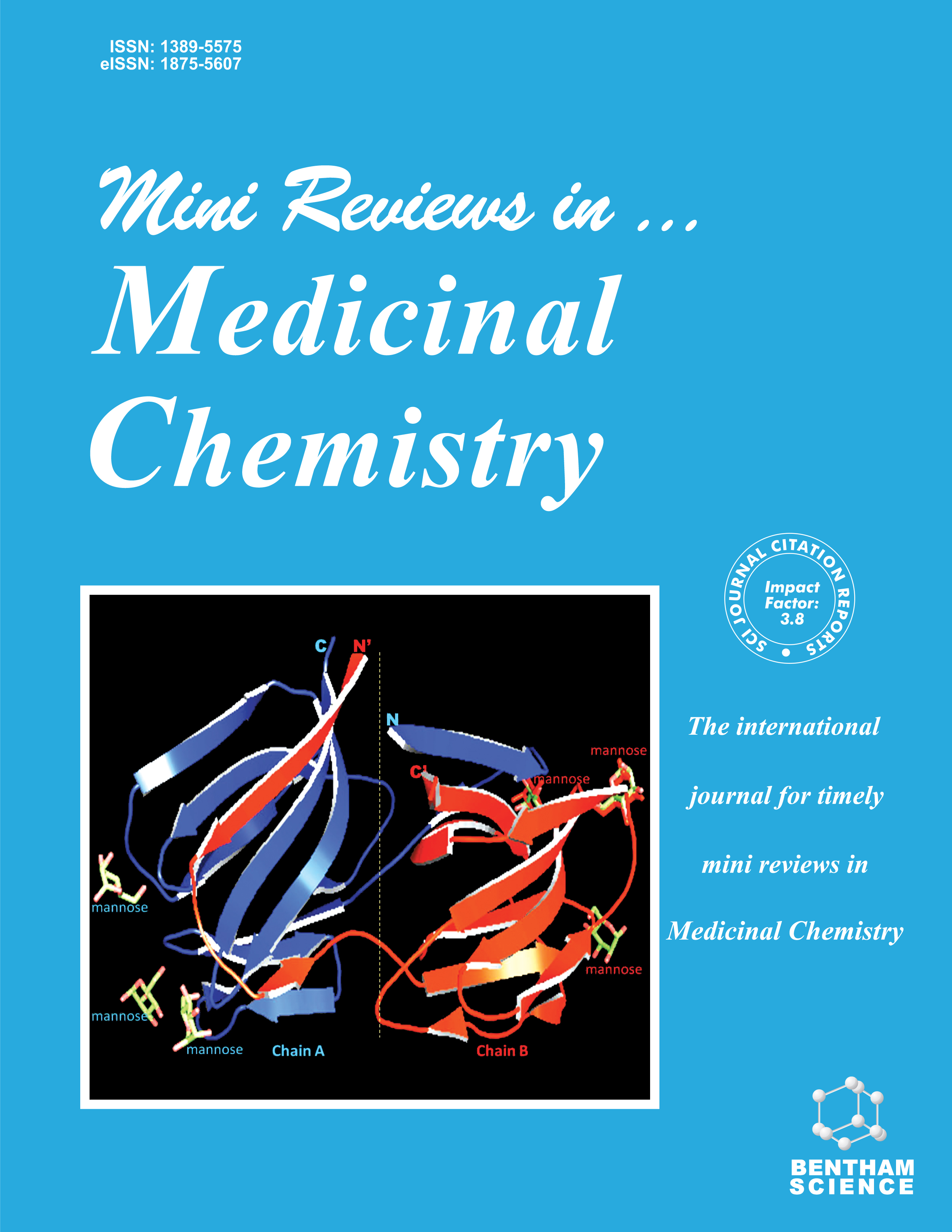- Home
- A-Z Publications
- Mini Reviews in Medicinal Chemistry
- Previous Issues
- Volume 24, Issue 13, 2024
Mini Reviews in Medicinal Chemistry - Volume 24, Issue 13, 2024
Volume 24, Issue 13, 2024
-
-
Ferroptosis is Involved in the Pharmacological Effect of Ginsenoside
More LessAuthors: Juling Feng, Haodong Chen, Yangbo Liu, Qidi Ai, Yantao Yang, Wenbin He, Lei Zhao, Shifeng Chu and Naihong ChenGinsenoside is the principal active ingredient in ginseng. Several investigations have found that ginsenosides have anti-inflammatory, antioxidant, anti-apoptotic, anti-cancer, and antiallergic activities. Ferroptosis is an iron-dependent, non-apoptotic form of cell-regulated death caused by lipid peroxidation. Iron, lipid, and amino acid metabolism orchestrate the complex ferroptosis response through direct or indirect regulation Read More
-
-
-
Quinoline Derivatives as Promising Scaffolds for Antitubercular Activity: A Comprehensive Review
More LessAuthors: Mohammad Owais, Arun Kumar, Syed M. Hasan, Kuldeep Singh, Iqbal Azad, Arshad Hussain, Suvaiv and Mohd AkilBackground: Heterocyclic compounds and their derivatives play a significant role in the design and development of novel quinoline drugs. Among the various pharmacologically active heterocyclic compounds, quinolines stand out as the most significant rings due to their broad pharmacological roles, specifically antitubercular activity, and their presence in plant-based compounds. Quinoline is also known as benzpyridine, benzop Read More
-
-
-
Targeting STAT3 Enzyme for Cancer Treatment
More LessA category of cytoplasmic transcription factors called STATs mediates intracellular signaling, which is frequently generated at receptors on cell surfaces and subsequently sent to the nucleus. STAT3 is a member of a responsible for a variety of human tumor forms, including lymphomas, hematological malignancies, leukemias, multiple myeloma and several solid tumor types. Numerous investigations have demonstrated c Read More
-
-
-
Targeting Ferroptosis: A Novel Strategy for the Treatment of Atherosclerosis
More LessAuthors: Yifan Zhang, Chengshi Jiang and Ning MengSince ferroptosis was reported in 2012, its application prospects in various diseases have been widely considered, initially as a treatment direction for tumors. Recent studies have shown that ferroptosis is closely related to the occurrence and development of atherosclerosis. The primary mechanism is to affect the occurrence and development of atherosclerosis through intracellular iron homeostasis, ROS and lipid peroxid Read More
-
-
-
Calcium Modulating Effect of Polycyclic Cages: A Suitable Therapeutic Approach Against Excitotoxic-induced Neurodegeneration
More LessAuthors: Ayodeji O. Egunlusi, Sarel F. Malan, Vitalii A. Palchykov and Jacques JoubertNeurodegenerative disorders pose a significant challenge to global healthcare systems due to their progressive nature and the resulting loss of neuronal cells and functions. Excitotoxicity, characterized by calcium overload, plays a critical role in the pathophysiology of these disorders. In this review article, we explore the involvement of calcium dysregulation in neurodegeneration and neurodegenerative disorders. A promisin Read More
-
-
-
The Use of Nanocarriers to Enhance the Anti-neuroinflammatory Potential of Dietary Flavonoids in Animal Models of Neurodegenerative Diseases: A Systematic Review
More LessAuthors: Gopalsamy R. Gandhi, Varghese Edwin Hillary, Kumaraswamy Athesh, Maria Letícia Carvalho da Cruz Ramos, Gabriela Peres de Oliveira Krauss, Gnanasekaran Jothi, Gurunagarajan Sridharan, Rengaraju Sivasubramanian, Govindasamy Hariharan, Alan B. S. Vasconcelos, Monalisa Martins Montalvão, Stanislaus Antony Ceasar, Valdete Kaliane da Silva Calisto and Ricardo Queiroz GurgelBackground: Neurodegenerative diseases (NDs) have become a common and growing cause of mortality and morbidity worldwide, especially in older adults. The natural flavonoids found in fruits and vegetables have been shown to have therapeutic effects against many diseases, including NDs; however, in general, flavonoids have limited bioavailability to the target cells. One promising strategy to increase bioavailability is t Read More
-
Volumes & issues
-
Volume 25 (2025)
-
Volume 24 (2024)
-
Volume 23 (2023)
-
Volume 22 (2022)
-
Volume 21 (2021)
-
Volume 20 (2020)
-
Volume 19 (2019)
-
Volume 18 (2018)
-
Volume 17 (2017)
-
Volume 16 (2016)
-
Volume 15 (2015)
-
Volume 14 (2014)
-
Volume 13 (2013)
-
Volume 12 (2012)
-
Volume 11 (2011)
-
Volume 10 (2010)
-
Volume 9 (2009)
-
Volume 8 (2008)
-
Volume 7 (2007)
-
Volume 6 (2006)
-
Volume 5 (2005)
-
Volume 4 (2004)
-
Volume 3 (2003)
-
Volume 2 (2002)
-
Volume 1 (2001)
Most Read This Month
Article
content/journals/mrmc
Journal
10
5
false
en


